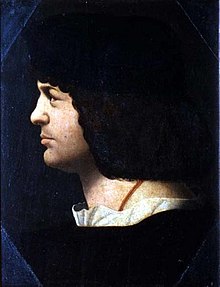Bernardino de Conti
Bernardino dei Conti , Nicolo de Conti , Italian Bernardino de Conti or Niccolò de Conti (* around 1470 in Castelseprio , † after 1522 ) was an Italian painter of the Renaissance era. He belonged to the Milan School, known for profile views in portrait painting.
biography
Little information is available on the life of the painter, who belonged to the family of the Counts of Castelseprio, as evidenced by the signature on the portrait of a man in Rome .
He completed his artistic training in Pavia , then moved to the court in Milan and was active there at the same time as other painters from Lombardy , including Leonardo da Vinci . Other contemporaries who were listed as Lombards were Buttinone from Treviglio , Giovanni Donato da Montorfano , Bartolommeo Suardi from Milan, later trained under Bramante and therefore called Bramantino , Ambrogio da Fossano, called Borgognone , Giovanni Ambrogio Bevilacqua , Vincenzo Civerchio from Cremam , Macrino from Alba , etc.
Works
De Conti's works show a great fondness for portraits of important personalities in Lombardy political life and, to a lesser extent, an interest in ecclesiastical images, such as a series of Madonna and Child and The Angels and Souls in Purgatory . The Annunciation for the Rusca altar in the pilgrimage church of Madonna del Sasso above Locarno (c. 1502) and the Madonna with the child and the little St. John , made in Milan (today preserved in the Accademia di Belle Arti di Brera ) are also remarkable .
In the art criticism of his time, De Conti was praised primarily for his profile views and is a trademark with which he stood out from the painters in the Leonardo da Vinci style. The profile view was actually a type of representation reserved for bas-relief portrait sculpture, such as for coins and portrait plaques. This turn to plastic came from the zeitgeist of the late 15th century in Milan. "In the second half of the 15th century, the large buildings of the Milan Cathedral and the Certosa di Pavia gave a major boost to sculpture and pushed painting somewhat into the background, because under the reign of Filippo Maria Visconti (1405–1447 ) only a few well-known painters have been promoted. " In his reflections on contemporaries of da Vinci de Conti's style, Münz writes: dry and precise, more of a burin than a brush. One of the most famous portraits by De Conti is the portrait of Ambrogio da Fossano ( 1501 ); the portrait of Catellano Trivulzio ( 1505 ); the portrait of Charles d'Amboise contained in the Pinacoteca di Varallo since 1500 .
literature
- Maria Teresa Fiorio: Bernardino de 'Conti. In: Historical Lexicon of Switzerland . April 1, 2004 , accessed February 27, 2020 .
- Maria Teresa Fiorio: Per il ritratto lombardo: Bernardino De Conti. In: Arte Lombarda , 1983.
- Gottardo Garollo (1907), Ulrico Hoepli , ed. Dizionario biografico universale. Editore Libraio della Real Casa, Milan. Page 571.
- The works of Italian masters in the galleries of Munich, Dresden and Berlin. A critical attempt by Ivan Lermolieff. Leipzig 1880 EA sailor.
- Eugène Müntz : Leonardo da Vinci. Volume 1 Parkstone International, New York 2008 page 137.
- Marco Tanzi: Bernardino De Conti. Annuncio della salvazione all anime del Purgatorio. In: Giovanni Agosti, Jacopo Stoppa, Marco Tanzi, “Il Rinascimento nelle terre ticinesi. Da Bramantino a Bernardino Luini », Officina Libraria, Milano 2010.
Web links
- Bernardino de Conti (Italian) on treccani.it/enciclopedia/
Individual evidence
- ^ "The Muse" de Agostini, Novara 1965 Vol.IV, page 111
- ^ The works of Italian masters in the galleries of Munich, Dresden and Berlin. In: de.wikisource.org. February 2, 2014, accessed January 9, 2015 .
- ^ Eugène Müntz: Leonardo da Vinci. Parkstone International, 2012, ISBN 978-1-780-42329-6 , p. 137. Limited preview in Google Book Search
| personal data | |
|---|---|
| SURNAME | Conti, Bernardino de |
| ALTERNATIVE NAMES | Conti, Bernardino dei (full name); Conti, Nicolo de; Conti, Niccolò de |
| BRIEF DESCRIPTION | Italian painter of the Renaissance era |
| DATE OF BIRTH | around 1470 |
| PLACE OF BIRTH | Castelseprio |
| DATE OF DEATH | after 1522 |

